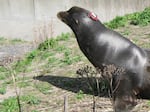Producer: Vince Patton Videographers: Nick Fisher, Todd Sonflieth, Michael Bendixen Editors: Greg Davis, Michael Bendixen Associate Producer: Cassandra Profita Additional Photos & Video: Columbia River Inter-Tribal Fish Commission, Cassandra Profita
On the last day of the spring salmon season on the Columbia River, sport anglers spotted competition for the fish they want to catch.
Half a dozen sea lions poked up their heads just beyond the reach of fishing lines.
Fisherman David Hylton from Redmond said, “I think we need to get them out of this system because this is not their natural habitat. They don’t live here.”
Historically, sea lions did not come up the Columbia. Lewis & Clark spotted harbor seals.
finding remains of seals but not sea lions as high up the river as Celilo Falls.
However, a growing number of sea lions have made the Columbia a frequent stopping point since the 1980s.

A record number of sea lions estimated at more than 2500 smothered the docks in Astoria in the spring of 2015.
Nick Fisher / Oregon Public Broadcasting
In 2015, sea lions set records. More than 2500 covered the docks in Astoria and surveys estimated nearly 5,000 in the lower Columbia River.
West coast populations have risen from about 180,000 in the late 1990s to nearly 300,000 in 2015.
Biologists, anglers and tribes all believe the sea lions are killing too many endangered salmon.
Government observers spend months watching the sea lions.
The official
sea lions eat from 3,00 to 5,000 salmon, though in 2015 that jumped to more than 8,000.
Doug Hatch, biologist with the
Columbia River Inter-Tribal Fish Commission
concedes they really don’t know how many salmon are eaten by sea lions.
“We know there’s a lot of sea lions in the river,” says Hatch, “but we don’t know what their predation rate is on salmon.”
Tribal biologists are experimenting with a high tech means to find out.
They have captured a handful of sea lions, glued a tracking device to their head and released them back to the river.

Biologists glued an accelerometer tag to the head of a sea lion in an attempt to track its body motions.
Columbia River Inter-Tribal Fish Commission
Hatch compares the tag to a fitness tracker people wear on their wrists. The sea lion tags measure the unique motions of a sea lion’s head, particularly when they eat.
Sea lions often thrash about, throwing their food.
It’s not play. They’re breaking the salmon up into pieces easier for them to eat.

A sea lion thrashes its head, tossing the salmon it has caught to break it up smaller to eat.
Nick Fisher / Oregon Public Broadcasting
“When they do that it’s a very unique, distinctive movement of shaking,” says Hatch. “We think we’ll be able to capture that on the accelerometer tag.”
Perhaps those tracking tags will show how many fish each sea lion eats when observers are not around to watch.
Learning how many salmon sea lions eat is more than an academic question. It directly affects how many more sea lions may be put to death in future years.
“It’s been quite controversial,” says Robin Brown, the marine mammal program leader for the
Oregon Department of Fish & Wildlife
.
Brown says if the
said it planned to modify Bonneville Dam in a way that would kill an additional 5,000 salmon each year, “It would never be permitted. The same is true from our perspective for the California sea lion predation on threatened and endangered salmon.”
Biologists received federal permission to take more extreme measures.
CRITFC helps with the first stage. They haze the animals by firing non-lethal noise-making shells from shotguns at sea lions near Bonneville Dam. The hazing lasts several months a year.

A Columbia River Inter-Tribal Fish Commission worker hazes sea lions with noise makers from a shotgun.
Nick Fisher / Oregon Public Broadcasting
ODFW has regularly branded thousands of sea lions for the last several decades. The brands are large enough to be read by observers.
If an individual sea lion has been exposed to non-lethal hazing and has been identified repeatedly eating salmon near the dam, that sea lion can be killed.
That infuriates Ninette Jones, an activist with the
.
Day after day, she arrives before dawn to watch and shoot video of the government’s sea lion trapping operation from the opposite side of the river.

Government biologists take select sea lions from traps to be euthanized at Bonneville Dam.
Todd Sonflieth / Oregon Public Broadcasting.
Jones believes sea lions are scapegoats when the impact of dams kills far more fish.
“We still had a million Chinook cross this dam. With our sea lions, with all the people, I think that’s pretty amazing,” says Jones. “For land mammals (humans) to allocate all the aquatic animals food source for themselves, I find that rather greedy.”
In eight years, the government has killed 85 sea lions and transferred another 15 to zoos.
Hatch, the CRITFC biologist, says he hopes their tracking tags will improve data showing whether sea lions are responsible for a substantial impact on salmon runs.
“It’s circumstantial,” says Hatch. “You have a large population of sea lions and you have this loss of fish. But we need a predation rate. We need a way to link those together before we could say, without a doubt that it’s a sea lion problem.”
Recent salmon runs in the millions have set records.
But tribal and government biologists believe allowing several thousand fish each year to disappear to predators still poses too great a risk to the salmon.
“None of us like the idea of having to kill animals, remove predators,” says Brown.
ODFW says it has no plans to remove large numbers of sea lions; it will target only those individuals identified as repeatedly eating salmon near the dam.
